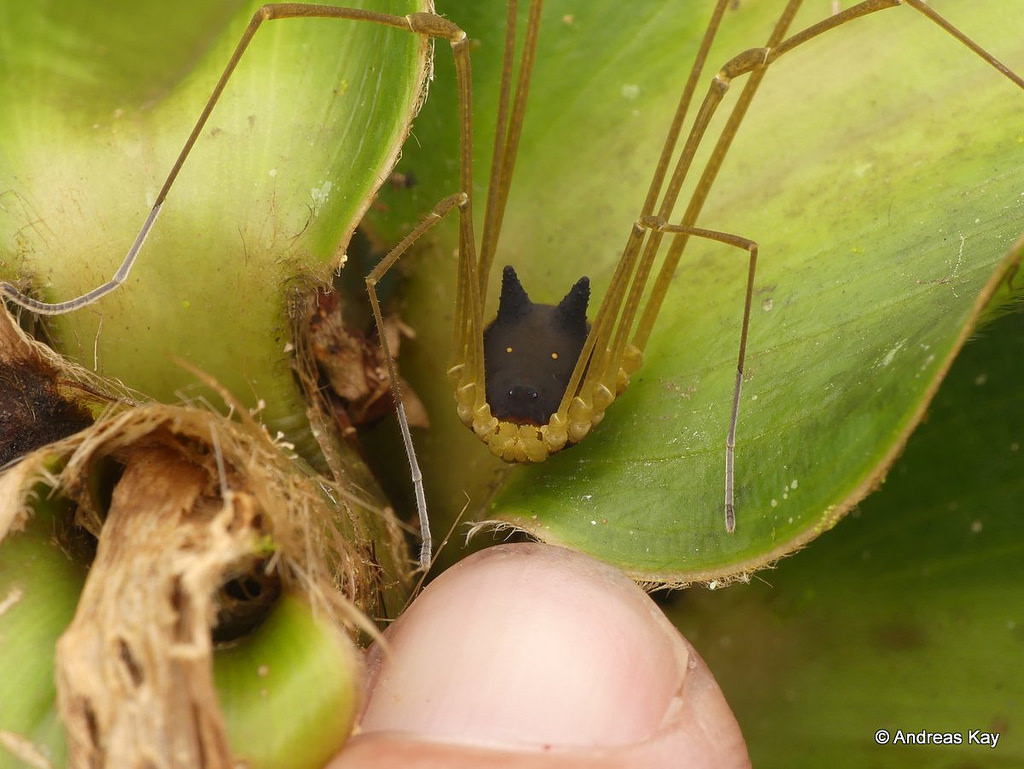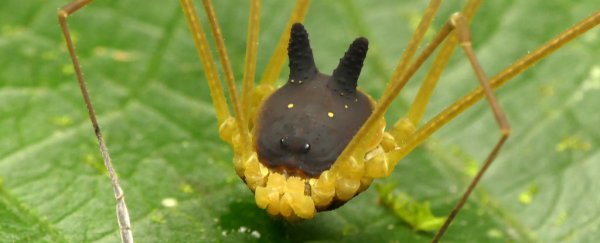The natural world is a strange and wonderful place. But sometimes biologists come across something that is just… odd. Really, really odd.
Case in point: this peculiar arachnid photographed by natural scientist Andreas Kay in Ecuador's Amazon rainforest in July 2017. By all appearances, it looks like it has the tiny head of a black wolf, or perhaps a bunny rabbit on its back.
Zoomed it, the thing looks formidable, although it's only roughly the size of a thumbnail. So, what the heck is this thing?
Firstly, it's not a spider, despite appearances.
Secondly, no, it's not photoshopped. And it's not just a trick of the light or photography. You can see another angle below.
 (Andreas Kay/Flickr/CC BY-NC-SA 2.0)
(Andreas Kay/Flickr/CC BY-NC-SA 2.0)
The creature is actually a bunny harvestman (Metagryne bicolumnata) - a type of arachnid better known as daddy longlegs.
Belonging to the order Opiliones, there are more than 6,650 species of harvestmen all across the planet. And fossil records show they've been around for a long time.
"Contrary to a common belief Harvestman [sic] do not have venom glands and are absolutely harmless," Kay explains over on Rumble. "Harvestmen have been around for at least 400 million years and lived even before the dinosaurs."
This species was discovered in 1959 by German arachnid specialist Carl Friedrich Roewer. Below you can see his early sketches of the adorable little creature.
 (Senck. Biol, 1959)
(Senck. Biol, 1959)
Why the strange head? Well, scientists aren't quite sure. For some reason, the arachnid has evolved this dark body, two ear-like protrusions, and bright yellow false eyes.
Its real eyes are located further down its body, which you can see in the image below.
 (Andreas Kay/Flickr/CC BY-NC-SA 2.0)
(Andreas Kay/Flickr/CC BY-NC-SA 2.0)
Kay hypothesises that this unique body shape could benefit the arachnid by making it look bigger to predators. But these ideas haven't been tested.
In fact, the animal hasn't been studied extensively, and there are very few published papers on it since its discovery almost 60 years ago.
That could be because there's a whole lot of other cool stuff to study in Ecuador - the country is, after all, home to the Galapagos Islands, as well as the Amazon rainforest, and has the highest biodiversity per square kilometre of any nation.
So for now, the bunny harvestman remains somewhat of a delightful mystery (albeit it a viral one).
But it definitely makes us happy that oddball creatures like this exist in the world; hopefully there are many more left to discover.
